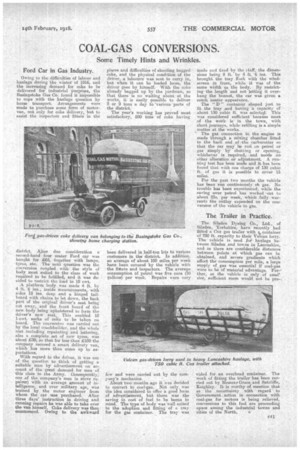COAL-GAS CONVERSIONS.
Page 17

If you've noticed an error in this article please click here to report it so we can fix it.
Some Timely Hints and Wrinkles.
Ford Car in Gas Industry.
Owing to the difficulties of labour and haulage during the winter of 1916, and the increasing demand for coke to be delivered far industrial purposes, the Basingstoke Gas Co. found it impossible to cope with the haulage question by horse transport. Arrangements were made to purchase some form of motorvan, not only for coke delivery, but to assist the inspectors and fitters in the district. After due consideration a -second-hand . four seater Ford car was bought for £65, together with lamps, tyres, etc. The next question was the conversion coupled with the style of body most suited to the class of work required to be fulfilled, and it was decided to restrict the load to 10 cwt.
A platform body was made 4 ft. by 4 ft. §• ins., inside measurements, with sides 18 ins, deep and a hinged tailboard with chains to let down, the back -part of the original 'driver's seat being cut away,. and the front board of -the new body being upholstered to form the driver's new seat. This enabled 10 1-cwt. sacks of coke to be taken on board. The conversion was carried out by the local eoachbuilder, and the whole cost including repainting and lettering, also a complete set of new tyres, was about 450, so that for less than £100 the company keenred a smart delivery van, which ha8 more than come up to expectations.
With regard to the driver, it was out of the question to think of getting a suitable man by advertisement on ace count of the great demand for men of this class in the Army. Consequently, one of the. company's men (a stove repairer) -with an average amount of intelligence, and over military age, was trained by the motor engineer from whom the car was purchased. After three days' instruction in driving and running repairs he was able to tali; over the van himself. Coke delivery was then commenced. Owing to the awkward places and difficulties of shooting bagged coke, and the physical condition of the driver, a labourer was sent to carry in, but when it. can be loaded loose, the driver goes by himself. With the coke already bagged up by the yardman, so that there is no waiting about • at the works, it is easily -possible to deliver 8 or 9 tons a day to -various parts of the district.
The year's working has proved most satisfactory, 850 tons of coke having been delivered in half-ton lots to various customers in the district. In addition, an average of about 100 miles Tier week have been covered by the vehicle with the fit•tere and inspectors. The average consumption of petrol was five cans (10 gallons) per week. Repairs were very few and were carried out by the company's mechanics.
About two months ago it was decided to convert to coal-gas. Not. only' was the idea considered to offer a good form of advertisement, but there was the saving in cost of fuel to be borne in mind. The type of body was well suited to the adoption and fitting of a tray for the gas container. The tray' •was• made and fixed by the staff, the dimensions being 8 ft. by 4 ft. -6 ins. This brought the tray flush with the windscreen in front, while it was of the same width as the body. By restricting the length and not letting it overhang the bonnet, the car was given a much neater appearance.
The "D" container shaped just to fit the tray And having a capacity Of about 130 cubic ft. was selectesl. This was considered eufficient because most of the work is. in the town, with short journeys, while refilling is a simple matter at the works.
` The gas connection to the engine is made through a mixing chamber fitted to the back end of .the carburetter so that the car may bite run on petrol or gas simply by shutting or opening, whichever is required, and needs no ether alteration or adjustment. A running test has been made and it has been found that with one charge of 130 cubic ft. of gas it is possible ta cover 15
miles. •
For the past two months the vehicle has been run continuously oh gas. No trouble has been experienced, while the saving over petrol has worked -oat to about 25s. per week, Which .fully warrants the outlay expended on the conv version of the vehicle to gas.
The Trailer in Practice.
The Silsden Dyeing Co., Ltd., of Silsden, Yorkshire, have recently had fitted a Cox gas trailer with a container of 750 ft. capacity to their Vulcan lorry. The vehicle is used fo haidage be-. tween Silsden and towns in Lancashire, -and as there are considerable distances between points -at Which gas can be obtained, and 'severe gradients which affect the consumption per mile, a large supply of gas was essential if coal-gas were to be of material advantage. Fur= ther, as the vehicle -is only of small sire, sufficient room would not be pro,: vided for, an overhead container. The work of fitting-the trailer has been carried out by Messrse Grace and Sutcliffe, Keighley. It is worthy of mention that as the uncertainty withregard to Government. action in connection with coal-gas for motors is being relieved, conversions to this fuel are proceeding apace among the industrial towns and cities of the North.






















